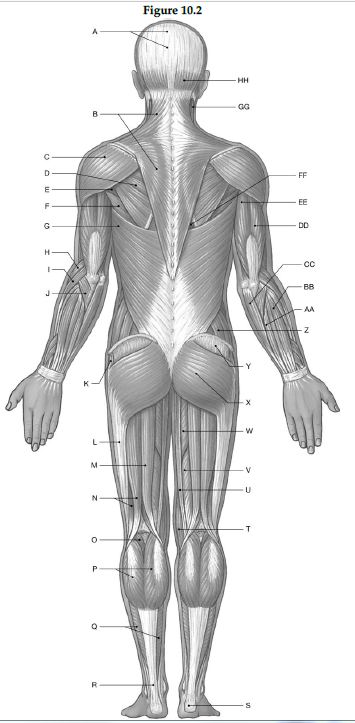Using the figure below, identify the labeled muscles.

1) Label A: ______________________________
2) Label B: ______________________________
3) Label C: ______________________________
4) Label D: ______________________________
5) Label E: ______________________________
6) Label F: ______________________________
7) Label G: ______________________________
8) Label H: ______________________________
9) Label I: ______________________________
10) Label J: ______________________________
11) Label K: ______________________________
12) Label L: ______________________________
13) Label M: ______________________________
14) Label N: ______________________________
15) Label O: ______________________________
16) Label P: ______________________________
17) Label Q: ______________________________
18) Label R: ______________________________
19) Label S: ______________________________
20) Label T: ______________________________
21) Label U: ______________________________
22) Label V: ______________________________
23) Label W: ______________________________
24) Label X: ______________________________
25) Label Y: ______________________________
26) Label Z: ______________________________
27) Label AA: ______________________________
28) Label BB: ______________________________
29) Label CC: ______________________________
30) Label DD: ______________________________
31) Label EE: ______________________________
32) Label FF: ______________________________
33) Label GG: ______________________________
34) Label HH: ______________________________
1) Epicranial aponeurosis
2) Trapezius
3) Deltoid
4) Infraspinatus
5) Teres minor
6) Teres major
7) Latissimus dorsi
8) Brachioradialis
9) Extensor carpi radialis longus
10) Anconeus
11) Tensor fasciae latae
12) Illiotibial tract
13) Semitendinosus
14) Biceps femoris
15) Plantaris
16) Gastrocnemius
17) Soleus
18) Calcaneal tendon
19) Calcaneus
20) Sartorius
21) Gracilis
22) Semimembranosus
23) Adductor magnus
24) Gluteus maximus
25) Gluteus medius
26) External oblique
27) Extensor carpi ulnaris
28) Extensor digitorum
29) Flexor carpi ulnaris
30) Triceps brachii (lateral head
31) Triceps brachii (long head
32) Rhomboid major
33) Sternocleidomastoid
34) Occipital belly of occipitofrontalis
You might also like to view...
Answer the following statement(s) true (T) or false (F)
1. Changes in tongue placement for vowels do not alter the vowel quality. 2. If [u] is produced with a slightly lowered tongue position, the resulting vowel quality will approximate [o]. 3. Secondary stress is marked with a straight superscript line in front of the syllable. 4. The glottal stop can be noted as a sound substitution in children with speech sound disorders. 5. Normal aspiration is typically marked in utterances.
What two molecules participate in cross-bridge interactions?
a. tropomyosin and myosin b. troponin and myosin c. troponin and tropomyosin d. actin and myoblasts e. actin and myosin
Imagine that you were asked to provide advice to a young adolescent about how to engage in healthy eating. The adolescent doesn't know much about nutrition, but likes to browse the Internet. What suggestions might you give for that young person for online learning and careful choices in the supermarket?
What will be an ideal response?
Which of the following are macronutrients?
A. Nucleic acids, carbohydrates, lipids, and proteins B. Carbohydrates, lipids, proteins, and water C. Sodium, potassium, calcium, chloride, and phosphorous D. Carbohydrates, lipids, and proteins, but not water E. Sodium, potassium, carbohydrates, lipids, and proteins